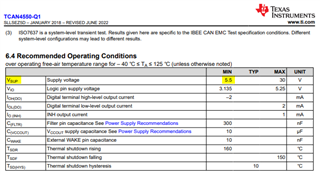Hi TI team,
we are using CC2340R as a MCU and TCAN4450 (TI) IC for CAN communication. In CAN datasheet, a clock-out pin shows for CAN clock.
1. We are using external 48Mhz crystal for radio communication and 48Mhz internal crystal is also there in CC2340 MCU. How can we use internal 48Mhz crystal oscillator of MCU for CAN clock by clk-out pin (as shown in datasheet)?
2. Can we make any GPIO as clock-out (20Mhz/40Mhz) in MCU ?
3. What are the other possibilities ?
4. We use buck converter in our design (Input - battery and output 3.3V). In that case we are are not enabling voltage regulator by INH pin (CAN IC) and left open, is that ok.
5. We are giving 3.3V to Vsup, WAKE, Vin.
Thanks
Munesh Tripathi



